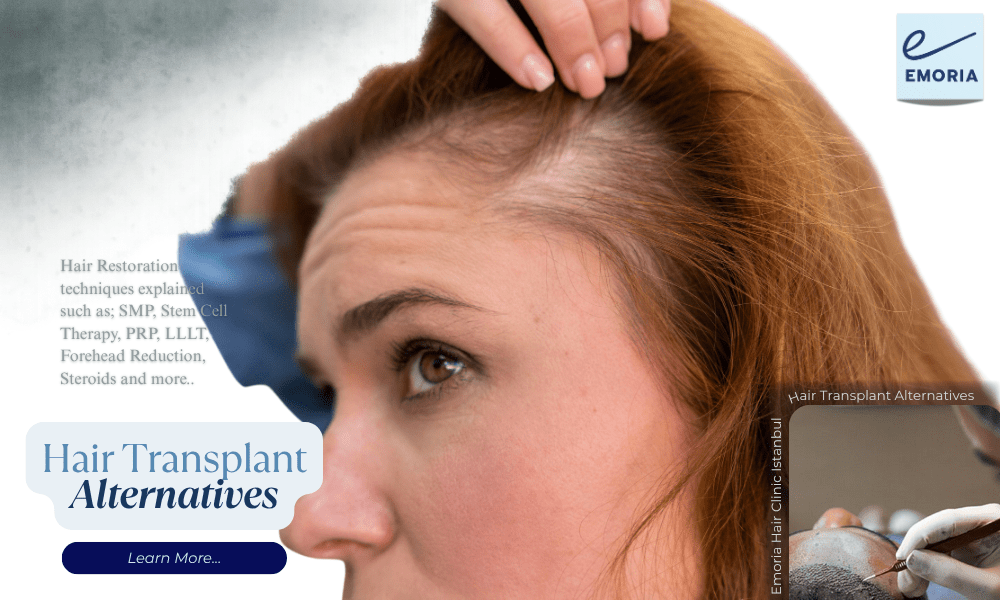Thinning hair, bald heads, receding forehead and patchy areas on your face usually send people running to the internet to find solutions to their hair loss. Many are pleasantly surprised to find that hair transplant is not the only remedy to achieve their previous gorgeous locks of hair or a full beard.
While the Emoria Clinic in Turkey provides superb service and excellent results for surgical hair transplant interventions, it also offers a range of non-surgical options to help restore your hair. The choices available will be determined by the extent of your hair loss, your age, and your health.
Thanks to major advances in regenerative medicine, aesthetics, and non-invasive dermatology, there are now safe and clinically proven ways to restore or maintain hair without undergoing surgery. Some stimulate real regrowth, others improve density, and some simply create the visual effect of a fuller head of hair—without weeks of recovery time or scarring.
If you’re exploring options, here’s a breakdown of the top 10 hair transplant alternatives we offer and recommend based on years of experience treating patients here at our clinic in Turkey.
Common Hair Restoration Treatments - Top 5
People tend to learn other hair restoration methods besides hair transplant if they have a reason to prevent them. Hair restoration clinics in Turkey offer many methods. Here are the top 5 methods our patients go for!
Scalp Micropigmentation (SMP)
Immediate visual results, no surgery required
Scalp Micropigmentation (SMP) is something we often suggest to patients looking for a non-invasive, cosmetic solution – especially if they’re not ready (or eligible) for a transplant.
SMP is not hair regrowth. It’s a specialized technique that uses pigment to create the illusion of tiny hair follicles. For men with shaved heads, it gives the appearance of a close buzz cut. For women, or for anyone with thinning at the crown or part, it adds shadow and density so the scalp is less visible.
We’ve had many patients walk out of an SMP session with an instant boost in confidence. It’s subtle, it’s long-lasting, and when done right, it’s incredibly natural-looking.
Stem Cell Therapy
The body’s own fat cells
Patients who are just beginning to notice thinning hair might be excellent candidates for Stem Cell Therapy. A small amount of fat tissue from your own body is collected from the abdomen or thigh. The stem cells are isolated and then injected into the scalp, improving scalp health and stimulating hair follicles. A healthier scalp stimulates growth in the hair follicles, which is noticeable within 3 to 6 months. There are usually no side effects from this procedure because your own cells are used in the procedure.
PRP Therapy (Platelet-Rich Plasma)
A favorite for a reason
If you’ve been researching hair restoration, you’ve probably come across PRP. It has become one of the most popular non-surgical options worldwide – and we frequently use it at Emoria, either on its own or in combination with other treatments.
PRP uses your own blood. We draw a small sample, spin it in a centrifuge to separate the platelet-rich plasma, and inject it directly into the scalp. Those platelets are rich in growth factors, which help “wake up” dormant follicles.
Patients typically require a few sessions to see results, but for many, PRP helps slow hair shedding, boost density, and even trigger regrowth—especially in areas where hair is thinning, rather than completely gone. This is another treatment that utilizes the body’s own cells, resulting in no side effects.
Low-Level Laser Therapy (LLLT)
Technology meets consistency
Laser caps and devices have gotten a lot of buzz lately—and for good reason. LLLT uses red light therapy to increase blood flow in the scalp and stimulate follicle activity.
What makes this treatment interesting is that it’s often used at home. We offer in-clinic laser therapy, but many patients prefer FDA-cleared laser caps that can be used 3–4 times a week while watching TV or reading. No needles, no pain—just consistent use over time. It’s particularly useful for patients who want to support other treatments like PRP or Minoxidil.
Forehead Reduction Surgery (Hairline Lowering)
For facial balance—not follicle regrowth
Although this is technically a surgical procedure, it’s not a hair transplant. Hairline lowering is done by moving the scalp forward to reduce the size of the forehead.
This is often an option for women—or men with a naturally high hairline—who want a better proportioned hair-to-forehead ratio. We perform this surgery at Emoria Clinic for select patients who are good candidates. It’s quick, safe, and the results are immediate.
While it won’t regrow hair, it does dramatically change appearance and can be life-changing for those self-conscious about a high hairline.

Common Hair Restoration Supplements - Top 5
Especially at the beginning of hair loss experience, people tend to research for medication with hair restoration effects. Also, before and after a Hair Restoration Treatment or Hair Transplant, these medications help the patient and the process a lot. Hair restoration packages in Turkish Clinics include many medications without extra pay. Here are the top 5 medications that help people the most!
Finasteride (Propecia)
A daily pill that prevents further loss
Finasteride is a well-known oral medication used to treat male pattern baldness. It works by blocking the hormone (DHT) that causes follicles to shrink.
This isn’t for everyone—women should avoid it, and men should be informed of potential hormonal side effects—but for the right candidate, it’s incredibly effective.
We often prescribe finasteride to patients in the early stages of thinning, as it can help preserve existing hair and prevent further loss. When combined with PRP or LLLT, results are even stronger.
Minoxidil (Topical and Oral)
Still one of the most dependable options available
Minoxidil (Rogaine) has been around for years, and for good reason. It’s one of the few treatments approved by the FDA for both men and women.
Applied as a foam or liquid twice daily, it helps increase blood flow to the scalp and prolongs the growth phase of hair follicles. Recently, oral minoxidil has been prescribed off-label in low doses for patients who can’t tolerate the topical version or want something simpler.
It’s often used as a foundation treatment—something you can combine with PRP, LLLT, or even stem cells to amplify results.
Spironolactone (For Women with Hormonal Hair Loss)
Treating the underlying hormonal cause
Hair loss in women is more complicated than many realize—and hormones often play a big role. Spironolactone is a medication that can help women who are dealing with hair thinning due to high androgen levels (common in PCOS or post-menopause).
It works by blocking the androgen receptors in the body, which helps prevent further follicle damage. When paired with oral minoxidil, we often see great results in women who’ve tried other treatments without success.
We always do a hormone assessment before recommending this option—but when it’s the right fit, it’s a game-changer.
Steroid Injections for Autoimmune Hair Loss (Alopecia Areata)
For patchy or sudden-onset hair loss
When hair loss is caused by an autoimmune issue like alopecia areata, we treat it differently. In these cases, corticosteroid injections directly into the bald patches can help reduce inflammation and allow the follicles to regrow.
It’s not a cure, but for many, it triggers regrowth within weeks. We recommend this only after a diagnosis is confirmed, and treatment is typically repeated every few weeks for a few months.
For patients who have suddenly lost clumps of hair, this treatment offers a targeted and effective solution.
Nutritional Support and Deficiency Testing
Hair loss sometimes starts from within
This one is often overlooked. Before we recommend any treatment plan, we test for common nutritional deficiencies that can cause or worsen hair loss—things like iron, vitamin D, B12, zinc, and thyroid function.
We’ve seen countless cases where correcting a simple deficiency made a significant difference. Hair is one of the first things your body sacrifices when it’s undernourished.
Combining Treatments for Better Results
In our experience, most patients don’t benefit from just one treatment. The best results are achieved through personalized combinations. For example:
- PRP + Minoxidil
- LLLT + Finasteride
- Stem Cell Therapy + Nutritional Support
- SMP + Medication
When we consult with you at Emoria, we consider a range of factors: your age, the pattern of hair loss, lab results, lifestyle, and your preference for a more aggressive or conservative approach.
Why Non-Surgical Hair Restoration Is a Smart First Step
You don’t have to jump straight to surgery to take your hair seriously. Whether you’re just starting to see more shedding than usual, or you’ve been managing thinning for years, there are safe, effective, and natural treatments available—right here in Turkey, at Emoria Clinic.
Many of our international patients start with non-invasive solutions to stabilize their hair loss, improve scalp health, and even see regrowth. And if a hair transplant becomes necessary later, their results are often better because they started early.
Your Transformation with Emoria
Educating our male and female patients about their nutrition and its impact on their overall well-being has been one of the most beneficial aspects of our consultations. Optimal health, combined with our non-surgical hair-loss treatments, not only improves their outward appearance but also their demeanor. They exude a new-found confidence rooted in the knowledge that they are responsible for their health, and ultimately, their appearance.
Knowing that we at Emoria Clinic have been a part of their journey is gratifying: a Cinderella transformation takes place before our eyes.
Are you ready for your own transformation?
References
Gentile, P., Garcovich, S., Bielli, A., Scioli, M. G., Orlandi, A., & Cervelli, V. (2017). The effect of platelet-rich plasma in hair regrowth: A randomized placebo-controlled trial. Stem Cells Translational Medicine, 6(3).
Avci, P., Gupta, G. K., Clark, J., Wikonkal, N., & Hamblin, M. R. (2014). Low-level laser (light) therapy (LLLT) for treatment of hair loss. Lasers in Surgery and Medicine, 46(2).
At Emoria Clinic, Platelet-Rich Plasma (PRP) Therapy and Low-Level Laser Therapy (LLLT) are among the most effective non-surgical treatments. These therapies stimulate natural hair regrowth and are ideal for patients in the early stages of hair loss.
PRP is most effective in areas where hair follicles are still alive but dormant. It typically does not regrow hair in completely bald areas, which may require other interventions such as stem cell therapy or hair transplantation
Scalp Micropigmentation (SMP) is a long-lasting cosmetic procedure that simulates the appearance of a full head of hair or density in thinning areas. While not permanent, its effects can last 4–8 years with occasional touch-ups.
Results vary depending on the treatment. PRP and Stem Cell Therapies typically show visible improvement within 3–6 months, while LLLT may require consistent use for several months before noticeable changes occur.
Absolutely. Many non-surgical treatments at Emoria Clinic, including PRP, oral minoxidil, and hormonal therapies like spironolactone are tailored specifically to address female-pattern hair loss and hormonal imbalances.

